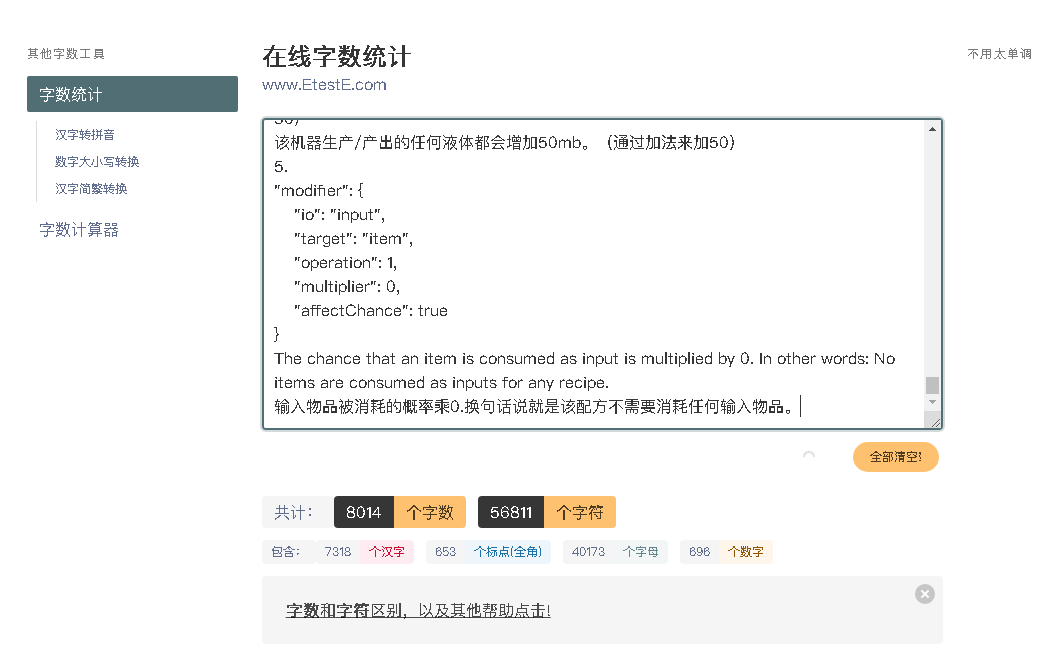本帖最后由 Eicy 于 2021-8-25 14:44 编辑
原文地址:https://github.com/HellFirePvP/ModularMachinery/wiki
翻译地址:https://mcbbs-wiki.cn/wiki/ModularMachinery_WikI
Curseforge:https://www.curseforge.com/minecraft/mc-mods/modular-machinery
统计
按删掉的作者的重复的废话翻译算的话 翻译的汉字:7318个
翻译人员提供的代码样例:4462个字符
翻译人员提供的样例配图:3张
总字数:8014个未将附件内演示代码算入统计数据

ModularMachinery
模块化机械官方Wiki翻译

原文地址

翻译地址
简介
模块化机械是一个专门为整合包制作者提供可自由定制机械的Mod,可通过修改JSON来实现对机械输出、输入、结构等参数的控制。模块化机械本体已足够强大,同时还可搭配 Modular Diversity 等附属并使用 Crafttweaker 可实现更多玩法。其中使用了ModularMachinery的国内著名整合包有 GreedyCraft贪婪整合包 EnigTech 2 等(不分先后)。如果你想更熟悉地使用MM的话,我建议你去翻翻其他使用了此mod的整合内的crt脚本和json,如果你还有余力而且有一定的编程基础,那我建议你去看看它和crt的源代码。
链接
原文地址:https://github.com/HellFirePvP/ModularMachinery/wiki
翻译地址:https://mcbbs-wiki.cn/wiki/ModularMachinery_WikI
Curseforge:https://www.curseforge.com/minecraft/mc-mods/modular-machinery
统计
按删掉的作者的重复的废话翻译算的话翻译的汉字:7318个
翻译人员提供的代码样例:4462个字符
翻译人员提供的样例配图:3张
总字数:8014个未将附件内演示代码算入统计数据

更多的橡胶树
ModularMachinery
模块化机械官方Wiki翻译
原文地址
翻译地址
简介
模块化机械是一个专门为整合包制作者提供可自由定制机械的Mod,可通过修改JSON来实现对机械输出、输入、结构等参数的控制。
模块化机械本体已足够强大,同时还可搭配 Modular Diversity 等附属并使用 Crafttweaker 可实现更多玩法。
其中使用了ModularMachinery的国内著名整合包有 GreedyCraft贪婪整合包 EnigTech 2 等(不分先后)。
如果你想更熟悉地使用MM的话,我建议你去翻翻其他使用了此mod的整合内的crt脚本和json,如果你还有余力而且有一定的编程基础,那我建议你去看看它和crt的源代码。
链接
原文地址:https://github.com/HellFirePvP/ModularMachinery/wiki
翻译地址:https://mcbbs-wiki.cn/wiki/ModularMachinery_WikI
Curseforge:https://www.curseforge.com/minecraft/mc-mods/modular-machinery
统计
按删掉的作者的重复的废话翻译算的话 翻译的汉字:7318个
翻译人员提供的代码样例:4462个字符
翻译人员提供的样例配图:3张
总字数:8014个未将附件内演示代码算入统计数据

2021.12 数据,可能有更多内容
ModularMachinery
模块化机械官方Wiki翻译

原文地址

翻译地址
简介
模块化机械是一个专门为整合包制作者提供可自由定制机械的Mod,可通过修改JSON来实现对机械输出、输入、结构等参数的控制。模块化机械本体已足够强大,同时还可搭配 Modular Diversity 等附属并使用 Crafttweaker 可实现更多玩法。其中使用了ModularMachinery的国内著名整合包有 GreedyCraft贪婪整合包 EnigTech 2 等(不分先后)。如果你想更熟悉地使用MM的话,我建议你去翻翻其他使用了此mod的整合内的crt脚本和json,如果你还有余力而且有一定的编程基础,那我建议你去看看它和crt的源代码。
链接
原文地址:https://github.com/HellFirePvP/ModularMachinery/wiki
翻译地址:https://mcbbs-wiki.cn/wiki/ModularMachinery_WikI
Curseforge:https://www.curseforge.com/minecraft/mc-mods/modular-machinery
统计
按删掉的作者的重复的废话翻译算的话翻译的汉字:7318个
翻译人员提供的代码样例:4462个字符
翻译人员提供的样例配图:3张
总字数:8014个未将附件内演示代码算入统计数据

|
|
|
|
|
|
|
|
|
|
|
|
|
本帖最后由 Eicy 于 2022-11-22 09:50 编辑
贡献名单:
Eicy:Home 6 7 8
垠儿:1 2 3 4
Citysands:9 10 11 12
喵鱿:5 13
MCBBS Wiki:https://mcbbs-wiki.cn/wiki/ModularMachinery_Wiki
贡献名单:
Eicy:Home 6 7 8
垠儿:1 2 3 4
Citysands:9 10 11 12
喵鱿:5 13
MCBBS Wiki:https://mcbbs-wiki.cn/wiki/ModularMachinery_Wiki
谢谢版主的分享
厉害啊版主,多谢分享
非常好用了
好耶!大家都好给力!
谁能来救救我啊!!!
来个大佬帮帮我吧
来个大佬帮帮我吧
aaaaaaaaaaaaaaaaaaa
感谢汉化贴
原文链接显示网页错误是什么原因
锁了呜呜呜
404了 这个教程还有么
ae能源不就好了?
这么好的帖子为什么要锁了 还废我一张挖掘卡



